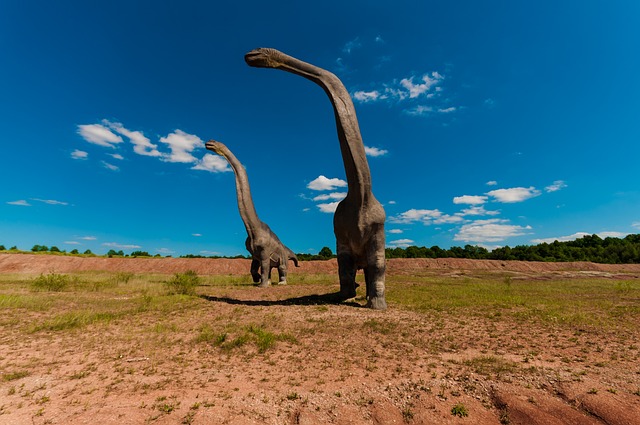Unearthing Dinosaur Fossils

This blogpost provides a comprehensive overview of the exciting field of paleontology, with a specific focus on the process of unearthing dinosaur fossils. From the intricacies of field work to the importance of such discoveries in understanding our earth's ancient past, this article provides a deep dive into the world of dinosaur fossils.
1. 'Revealing the Hidden: How are Dinosaur Fossils Discovered?'
The discovery of dinosaur fossils is truly a remarkable feat that requires a combination of luck, scientific expertise, and sheer determination. Paleontologists, scientists specializing in the study of ancient life, play a crucial role in unearthing these prehistoric treasures. The process typically begins with extensive research and geological mapping to identify potential fossil-rich areas. Once a promising location is found, field expeditions are organized, often spanning several weeks or even months. During these expeditions, paleontologists carefully scour the rocks, looking for any signs of fossils that may be hidden beneath the surface.
When a potential fossil is found, the delicate process of excavation begins. The area surrounding the fossil is carefully cleared, and meticulous records are kept to document the precise position and orientation of the find. Special tools and techniques are employed to carefully extract the fossil from its rocky tomb, ensuring that it remains intact and undamaged. This painstaking process requires patience and expertise, as even the slightest mistake can result in irreparable damage to the fossil.
In some cases, dinosaur fossils are discovered by complete chance. Construction projects, such as digging for new buildings or roads, have occasionally unearthed these ancient remains. Additionally, fossil hunters, often amateur enthusiasts, may stumble upon dinosaur bones while exploring remote areas or during organized fossil-hunting trips. These unexpected discoveries highlight the unpredictable nature of finding dinosaur fossils and the importance of remaining vigilant in the search for ancient life.
עבור מידע על At Dinosaurzus Dinosaur Store יש לגלוש לאתר dinosaurzus.com
2. 'Delicate Endeavor: What's the Process of Excavating Dinosaur Fossils?'
Excavating dinosaur fossils is a meticulous and delicate endeavor that requires great care and precision. Once a fossil is discovered, the first step is to carefully remove any surrounding sediment or rock layers. This is done gradually, using small brushes, dental tools, and even air scribes to avoid damaging the fragile bones or other remains. The process can be painstakingly slow, as each layer is removed millimeter by millimeter to ensure the preservation of the fossil.
To protect the fossil during excavation, a special hardening material called a consolidant is often applied. This strengthens the fossil and helps prevent it from crumbling or breaking apart. Once the fossil is stabilized, a protective jacket made of plaster or burlap soaked in a mixture of plaster and water is carefully applied around it. This jacket serves to support and protect the fossil during transportation to the laboratory.
Once the fossil is safely transported to the lab, the painstaking task of removing the remaining rock matrix surrounding the bones begins. This process, known as preparation, requires the use of specialized tools such as air scribes, needles, and even lasers. The goal is to remove the rock while preserving the delicate structure of the fossil. This can be a time-consuming process, taking months or even years to complete depending on the size and complexity of the fossil.
3. 'The Bigger Picture: Why are Dinosaur Fossils Important?'
Dinosaur fossils hold immense importance in our understanding of the Earth's history and the evolution of life on our planet. They provide us with valuable insights into the ancient ecosystems, climate conditions, and the behavior of these magnificent creatures. By studying dinosaur fossils, scientists are able to piece together the puzzle of the past, unraveling the mysteries of our planet's distant past.
One of the primary reasons why dinosaur fossils are important is that they allow us to study the evolution of life on Earth. These fossils provide evidence of the existence of different species, their physical characteristics, and how they adapted to their environments over millions of years. By analyzing these fossils, scientists can trace the lineage of dinosaurs and their relationships to other animals, giving us a better understanding of how life has evolved and diversified.
Additionally, dinosaur fossils offer valuable insights into the ancient climate and environment. By studying the fossilized remains of plants and animals found in the same geological layers as dinosaur fossils, scientists can reconstruct the ecosystems in which these creatures lived. This information helps us understand how the Earth's climate has changed over time and how these changes have influenced the evolution of life on our planet.
Furthermore, dinosaur fossils have significant educational value. They capture the imagination of people of all ages and inspire curiosity about the natural world. Museums and educational institutions use dinosaur fossils as teaching tools to engage students and the general public in the study of paleontology and the natural sciences. The study of dinosaurs also fosters scientific literacy and critical thinking skills, encouraging a deeper understanding and appreciation of the world around us.
4. 'What Mysteries do the Fossils Hold: What have we Learned from Dinosaur Fossils?'
Dinosaur fossils have allowed scientists to uncover a multitude of mysteries and gain invaluable knowledge about these ancient creatures. One of the most significant discoveries from dinosaur fossils is the understanding of their size and anatomy. Fossils have revealed the immense size and structure of dinosaurs, helping us understand their physical capabilities and evolutionary adaptations. Additionally, the study of dinosaur fossils has shed light on their locomotion and how they moved, whether on two legs or four, and how they interacted with their environment.
Furthermore, dinosaur fossils have provided insights into their behavior and social structures. Fossilized trackways and bonebeds have revealed evidence of herd behavior and group dynamics, suggesting that some dinosaurs were social animals that lived and moved in groups. These findings challenge the previous notion of dinosaurs as solitary creatures and give us a glimpse into the complex social lives of these ancient beings.
Moreover, the study of dinosaur fossils has allowed scientists to understand their dietary habits and feeding strategies. By examining the teeth and jaw structures of different dinosaur species, researchers can determine whether they were herbivores, carnivores, or omnivores. This information helps us reconstruct the food webs and ecological relationships between dinosaurs and their prey or plant sources, providing valuable insights into the ancient ecosystems in which they lived.
In addition to these discoveries, dinosaur fossils have also contributed to our understanding of extinction events and the impact of catastrophic events on the Earth's history. The fossil record shows evidence of mass extinctions, including the extinction of the non-avian dinosaurs around 65 million years ago. By studying these fossils, scientists can better understand the factors that led to these mass extinctions and how they shaped the subsequent evolution of life on our planet.
Unearthing dinosaur fossils is a complex and meticulous task that requires a combination of scientific knowledge, patience, and a dash of luck. The discoveries made in this field have significantly shaped our understanding of earth's history and the evolution of life. Although there's still much to learn, each unearthed fossil brings us one step closer to unraveling the mysteries of our planet's prehistoric past.




